
Upgrade your rabbit’s and guinea pig’s home with the range of Zippi Tunnels and Runs – now all with free delivery for a limited time only!
This offer is available on ALL Zippi Tunnels, Playpens, Runs and accessories, so you can create your pet’s perfect play area with free and fast delivery – ready for spring!
Use promo code ZIPPISAVE at checkout for free delivery!
Connect your rabbit’s or guinea pig’s hutch to a brand new run with the Zippi Tunnel System, perfect for providing your pet access to more space to play and exercise via the safe, predator proof tubes.
Available with a number of accessories to suit your needs, your very own Zippi Tunnel System can be easily designed with our online configurator, complete with lockable doors, hay racks, look out stations and more, or choose from one of our popular starter packs.
Designed to be easily connected to the Zippi Tunnels, the new range of Zippi Playpens and Runs provide a movable solution to giving your rabbit or guinea pig more space, making them happier and healthier.
The Zippi Playpen is an open style exercise and play space that provides easy access for children and pet owners alike and is great for interactive play. The Zippi Run offers a secure space for your rabbit to exercise unsupervised and comes with an enclosed roof and an option of underfloor mesh or a surrounding mesh skirt.
Don’t forget to complete your pet’s new play area with the range of Zippi weather protection so that playtime can carry on whatever the weather!
If you already have a Zippi Run you can now provide your pets with even more space, thanks to the Zippi Run Extensions.
Terms and Conditions
Free delivery promotion is only valid from 09/08/19 – midnight on 12/08/19. For free delivery use promo code ZIPPISAVE. This offer is available on all Zippi tunnels, accessories, playpens and runs only. Free delivery applies to order containing Zippi products to the minimum order value of $100. Offer applies to Standard Delivery Service only. Free delivery offer is not redeemable on pallet deliveries. Omlet cannot take responsibility for third party supplier delays such as courier service. Free delivery is only valid for orders shipped to Australia.
Subject to availability. Omlet ltd. reserves the right to withdraw the offer at any point. Offer is only valid on items from our Zippi range and cannot be used on existing discounts or in conjunction with any other offer.
This entry was posted in Guinea Pigs
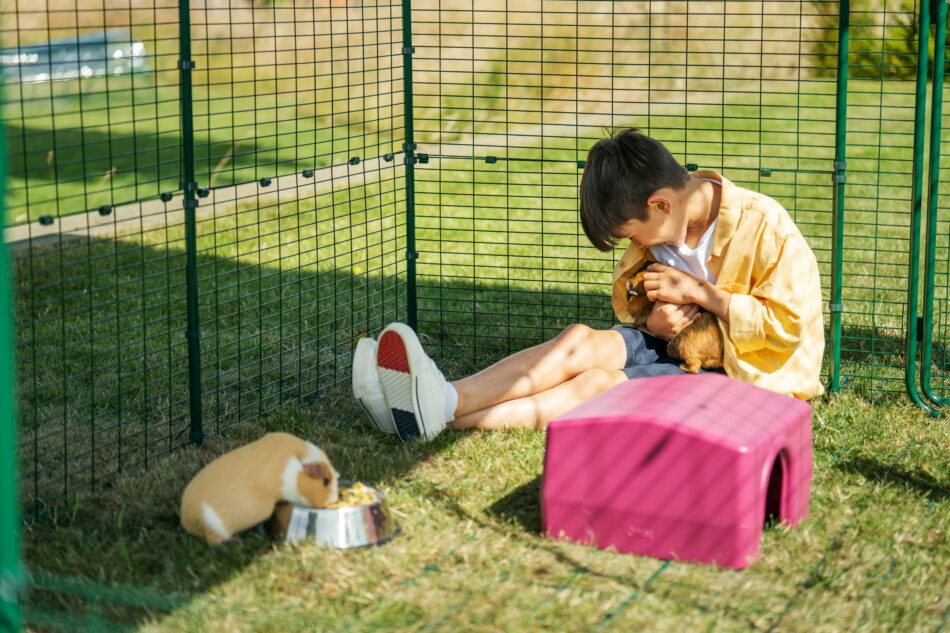
If you’re considering getting a guinea pig, you’re in good company. Guinea pigs (also known as “cavies”) are fun, quirky companions for people of all ages. Though small, these little animals make great pets that are full of character and personality. They’ll happily greet you with a series of adorable noises, affectionately nuzzle you during cuddling sessions, and provide you with hours of entertainment through their various eating and play habits. If you’ve ever owned a guinea pig, you know firsthand how enjoyable and rewarding it can be to have a guinea pig in your family. But, if this is your first time owning a guinea pig, here’s a checklist of everything you need.
A friend for your guinea pig
In the wild, guinea pigs live in groups called “herds”. They’re very social by nature and do best when they have a friend or two. Often guinea pigs will establish bonded pairings, but sometimes a group of 3 can be inseparable. A lone guinea pig will become depressed quickly, so be sure to plan on keeping at least 2 guinea pigs from the start.
Same-sex siblings are often a desirable pairing. Other same-sex pairings may also be successful, but you’ll want to introduce them slowly before housing them together. Be sure to only keep neutered males with females — otherwise, you’ll end up with accidental guinea pig pups. The idea of baby guinea pigs may sound cute, but behind the cuteness is a lot of extra care and having to separate males from females when they’re old enough to be weaned. And, unless you’ve got a lot of space or multiple setups, you’ll also need to find homes for the pups.
A cozy cavy hutch
Your guinea pigs will need a hutch to live in, even if you intend to keep them in your home. Whether you opt for a modern hutch like our Eglu Go guinea pig hutch or an indoor hutch option, you’ll need to weigh your decision carefully.
A good hutch is vital to a guinea pigs’ wellbeing. It’s their home, and where they’ll spend the majority of their time. Well-made hutches provide a secure environment for your guinea pigs to sleep, socialize, and exercise, and it will last you and your pets many years. And, by investing in a high-quality hutch, you won’t have to worry about maintenance or replacements.
The Eglu Go hutch can comfortably house 2-3 guinea pigs, and is the easiest cavy home you’ll ever have the pleasure of cleaning. Our unique design encourages your guinea pigs to express their natural behaviors, making them feel right at home from the beginning. And, with twin-insulated walls, your cavy will stay comfortable in any season.
It’s a common misconception that guinea pigs can’t be housed outdoors year-round. When they’re provided with quality shelter and space, they adapt well in natural settings. Special care should be taken during extreme weather conditions and temperatures, but guinea pigs can live outdoors safely the majority of the year in a setup like the Eglu Go guinea pig hutch.
It’s important to note that guinea pigs should be brought inside when temperatures are consistently above 80 degrees or below 50 degrees. Unless you’re able to check on them every couple of hours during temperature dips or spikes, it’s best to bring them in a temperature-controlled environment.
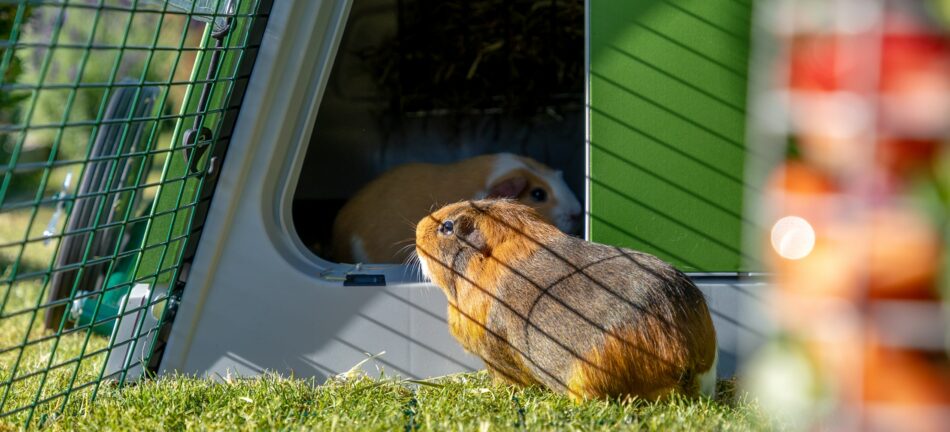
Space to exercise and play
Like most pets, guinea pigs thrive when they have as much space as possible. It’s especially important for guinea pigs to have room to exercise, as they are prone to obesity. Their little legs are adorable, but struggle under extra weight. The attached run of the Eglu Go guinea pig hutch offers your cavy room to run and play, but you can give them even more space by adding Zippi Guinea Pig Runs and Playpens.
The Zippi Guinea Pig Tunnel System brings all of this together by creating a route between their hutch and playpen. In the wild, guinea pigs seek shelter in burrows or tunnels constructed by other animals. They’re constantly on the lookout for potential threats, so providing hideouts and tunnels appeals to their desire to seek shelter. And, with convenient attachment kits, the Zippi guinea pig tunnel system can be connected to wooden hutches or any wire run easily.
For additional exercise, Zippi Guinea Pig Platforms can be installed inside of our playpens. The ramp is specially designed for little cavy legs, and the safety rails help prevent accidental tumbles. Zippi platforms are a great way to utilize aerial space, and to help you interact with your guinea pig on a whole new level — literally.
A quality diet and fresh water
Guinea pigs should have free-choice access to quality pellets and fresh water at all times. Their feed should consist of timothy hay-based pellets, rather than the “trail mix” variety of food. When offered this mix, cavies will pick out their favorite bits and leave the more nutritious pieces behind. Since guinea pigs can become overweight easily, it’s important to only feed them foods that offer nutritional value and not empty calories.
Cavies are in the rodent family, and as such, their teeth continuously grow. To combat this, make sure they have access to loose timothy hay at all times. In the wild, guinea pigs graze on grasses and plants all day long to help keep their teeth trimmed and their bellies in working order. In addition to their hay, offer your guinea pigs fresh herbs, leafy greens, and guinea pig-safe vegetables in moderation to round out their diet. As an occasional treat, you can serve your guinea pigs small pieces of fresh fruit.
Vitamin C
Guinea pigs are among a small group of mammals that can’t make their own vitamin C. Like humans, they need their daily dose of this essential vitamin in order to stay healthy. Most commercially made guinea pig pellets have vitamin C added, but be sure to check labels.
There are multiple other ways to make sure your guinea pigs are getting enough vitamin C. These include:
- Store-bought vitamin C drops to add to their water
- Offer vitamin C-rich veggies like broccoli, bell pepper, or dark leafy greens
- During playtime, reward your cavy with vitamin C-rich fruits like strawberries
A predictable routine
Guinea pigs will find comfort in their daily routine and soon come to expect their meals, playtime, and bedtime. They’ll also quickly learn that you are the bringer of food, playtime coordinator, and provider of safety — and will reward you with friendly squeaks and other noises from guinea pig vernacular.
Plan to check in on your guinea pigs at least once a day, but the more you interact with themes, the better your bond will be. Your cavies will soon anticipate your visits and will be more active when you spend time with them.
Omlet has all your guinea pig needs
We’ve designed comfortable cavy homes that keep your guinea pigs safe while making caring for them easier than ever for you. Our Eglu Go guinea pig hutch, Zippi Guinea Pig Tunnel System, and Zippi Guinea Pig Runs and Playpens are instant housing and enrichment solutions for cavy keepers of all ages and experience levels. With Omlet, you’ll be able to start keeping guinea pigs with success from the beginning.
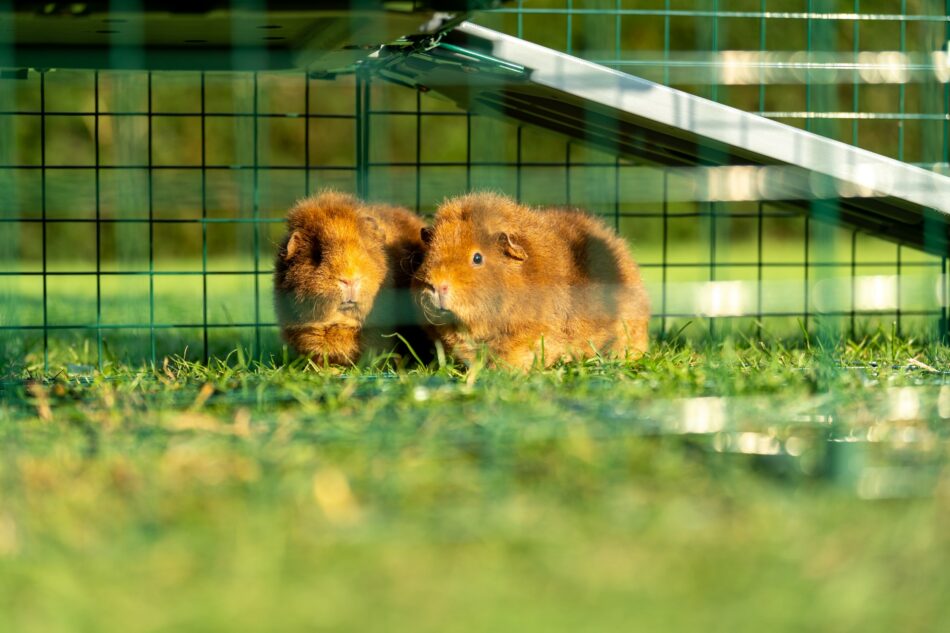

This entry was posted in Guinea Pigs
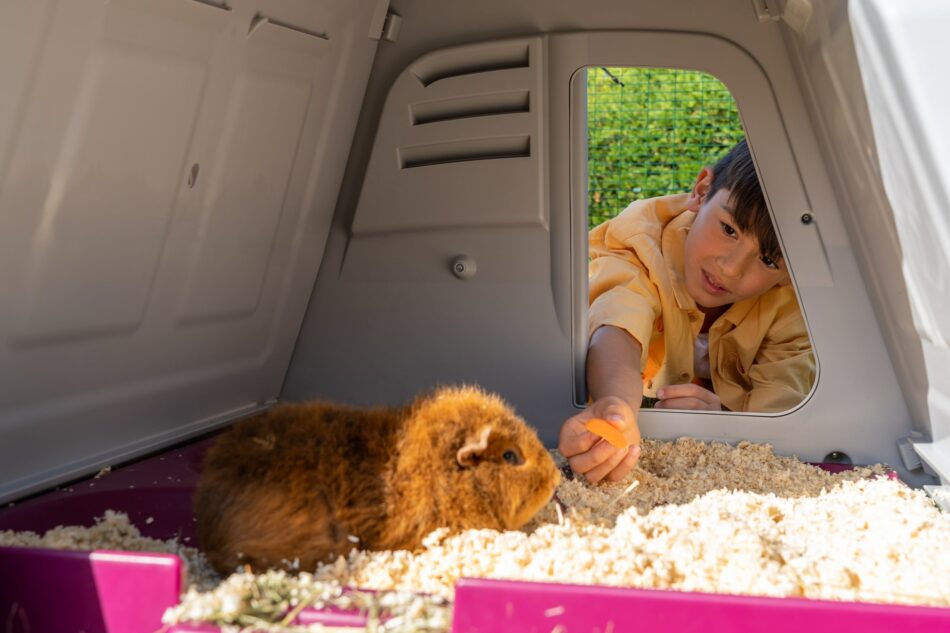
Guinea pigs are amazing, social pets that have lots to offer the families that share a home with them. But do you know how they got their name, how much (or little) they sleep, and how many toes they have? These 12 facts you might not know about your guinea pig will increase your love and appreciation for your cavies.
1. What’s in a name?
“Guinea pig” is actually a misnomer. They aren’t from Papua New Guinea — rather, they originate from the Andes mountains of Peru. The first part of their name is due to them being sold for a guinea (an old English coin) when sailors brought them from South America.
2. Not pigs at all
The second half of a guinea pig’s name is also a misnomer. They aren’t related to pigs at all — they’re actually members of the rodent family. Guinea pigs are so named because of the grunting noises they make, which reminded people of piglets. The other term for guinea pigs is “cavies”, or singular, “cavy.” It comes from their scientific name Cavia porcellus, with porcellus meaning “little pig.”
3. Even more misnomers
Like pigs, male guinea pigs are called boars and females are called sows. But, instead of baby guinea pigs following suit and being called piglets, they’re called pups. Even though their names imply they are similar to puppies at birth, this too, is incorrect. In reality, canine puppies and guinea pig pups have very little in common at birth.
4. Born ready
“Pups” are born with fur and their eyes open, and are very mobile from an early age. Most other species of rodents are born hairless and blind, unable to venture beyond their nest during the first few days of life. Guinea pig pups can see, walk, hear, and even have teeth. This gives them an advantage as prey animals in the wild.
5. Size and stature
Fully grown guinea pigs weigh between 1 and 3 pounds and are 8 to 16 inches long. Boars tend to be larger than sows, but should not be overweight. Guinea pigs are prone to obesity, which may be difficult to detect due to their oblong, potato-like shape. Cavies are considered overweight if you can’t feel their spine, ribs, or hips through their fat, or if they develop visible fat pads.
6. A longer lifespan than other rodents
Small pets aren’t known for their long lifespans, but guinea pigs actually live a relatively long life when they’re well cared for. The average lifespan of a domesticated guinea pig is 5-7 years.
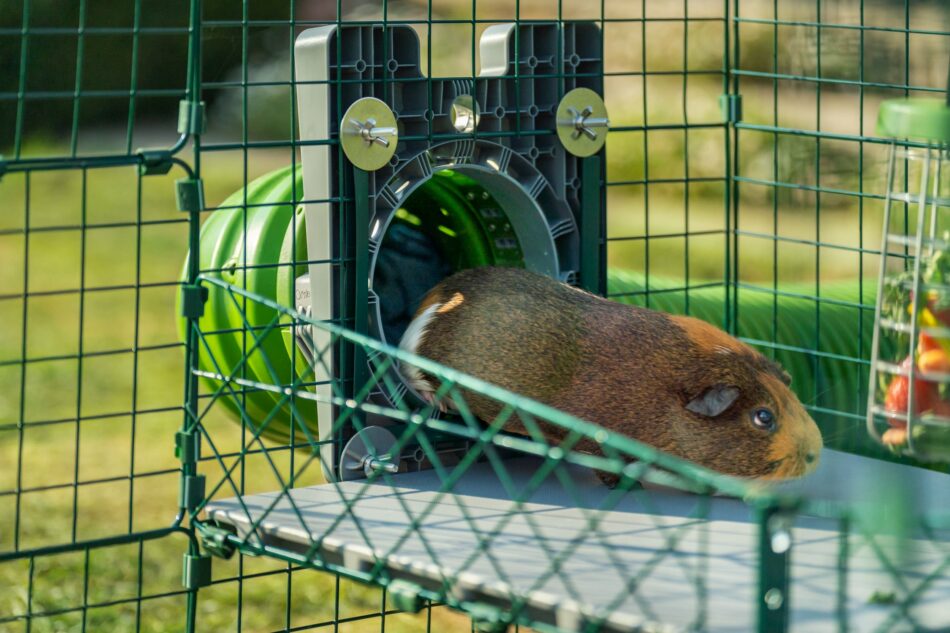
7. Abnormal number of digits
Guinea pigs have 4 toes on their front feet, but only 3 on their back feet. This brings their total toe count to 14. But, some guinea pigs may have more than the expected number of toes if they have a condition called “polydactyly” which is a genetic mutation that causes extra toes to grow.
8. Ever-growing teeth
Like other rodents, cavy teeth grow continuously throughout their lives. It’s important to give them food and treats to gnaw on to help them keep their teeth in check. Serving your guinea pigs’ favorite chews in a Caddi guinea pig treat holder will help keep their teeth-trimming treats at an accessible level.
9. Surprisingly little sleep
Guinea pigs don’t sleep much. In fact, they only sleep about 4-6 hours in a 24-hour period. They’re also proficient in power napping — taking short naps lasting anywhere from a few seconds to a few minutes, but usually not more than 30 minutes at a time. Cavies need a comfortable guinea pig hutch to get optimum rest during these short slumbers.
10. Very vocal
Guinea pigs have their own language, and are extremely vocal. Their broad range of noises include: purring, whining, shrieking, cooing, rumbling, hissing and teeth chattering. It’s very common for guinea pigs to greet their owners in what cavy keepers have dubbed a “wheek” — a happy, excited noise that a guinea pig emits.
11. Cavy companions
Guinea pigs are very social animals and need companionship to thrive. Their vast vocabulary and social relationships are best shared with other cavies. Bonded pairs are usually the happiest, but some guinea pigs will happily live in a social group of 3 or more. Remember to only keep same-gendered or spayed and neutered pairs together to avoid accidental litters.
12. A coat for every occasion
Guinea pigs come in a variety of colours and textures. Their different breeds create long and short coats with textures ranging from curly and wavy, to short and smooth, to no hair at all.
Owning guinea pigs with Omlet
Cavies are cute, quirky pets that the whole family can enjoy. By housing them in secure outdoor guinea pig hutches, you’ll be able to observe all of the wonderful attributes that your cavies display. Elevate their favourite foods and watch them exhibit these natural behaviours while observing the unique attributes that make guinea pigs some of the most entertaining and enjoyable pets to share your space with.
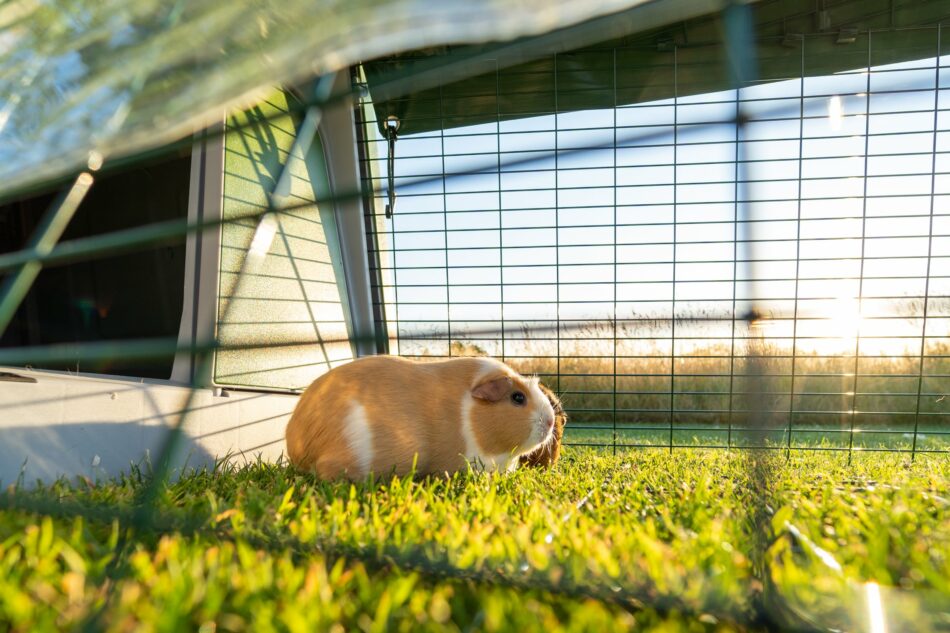
This entry was posted in Guinea Pigs



Last month, the Danish championships for guinea pigs were held in Copenhagen. The championships were hosted by Dansk Marsvineklub (The Danish Guinea Pig Association). The association’s purpose is to spread knowledge about the animals, and how to best care for and feed them and shows are held throughout the country where members meet up and exhibit their animals.
There were 3 main classes:
- Pure bred: Judged by the standard for each breed, for example whether the hair is properly coloured, if the eyes and ears are large and are placed correctly etc.
- Pets: All animals are welcome and emphasis is placed on the animal’s general condition, well-being and temperament. Denmark is known for the best pets throughout the Nordic region. We will return to this point…
- Juniors: A class for exhibitors under the age of 15. Same requirements as for the pets class, however, here emphasis is also placed on the interaction between children and animals and the child’s knowledge of the daily care
In addition, there are also some “for fun” competitions:
- Dress up competition
- Cucumber eating
- Weight competition
WINNER OF THE DRESS UP COMPETITION
The winner of the dress up competition was 5 month old Bluebells Teddiursa who was dressed as a dinosaur!


Here’s some of the other dress up entries!



WINNER OF THE CUCUMBER-EATING COMPETITION
How did you prepare for this competition?
“The animals feel safe with us – this is the theory. They feel so safe when we’re standing down there at the table. So they come to us and because they know we’re there and looking after them, they just dare to sit and eat and relax. Even the little one there who’s 2 months old, he was number 3 in the competition. We were number 1, 2 and 3 – and that happens almost every time. We take the guinea pigs up and feed them every day, they’re real pets! So you could say that we are practicing every day.”
This family (mother and two sons) were number 1, 2 and 3 in the cucumber-eating competition this year. The boys are both 14 years old, so it’s the final year that they’re allowed to compete in the junior class. Next year they have to compete with the pets. How do they feel about this?
“Well we’re already allowed to compete with the pets now – it’s only the adults that can’t compete with the juniors.”
The family has only once returned home from a guinea pig show without the cucumber-eating rosette.
“This was in February. Their favourite guinea pig was ill and they decided that she should be allowed to compete in the cucumber competition one last time, even though they knew she probably wouldn’t win it.”
You can learn more about Guinea Pigs by reading the Omlet Guinea Pig Guide here
This entry was posted in Guinea Pigs















